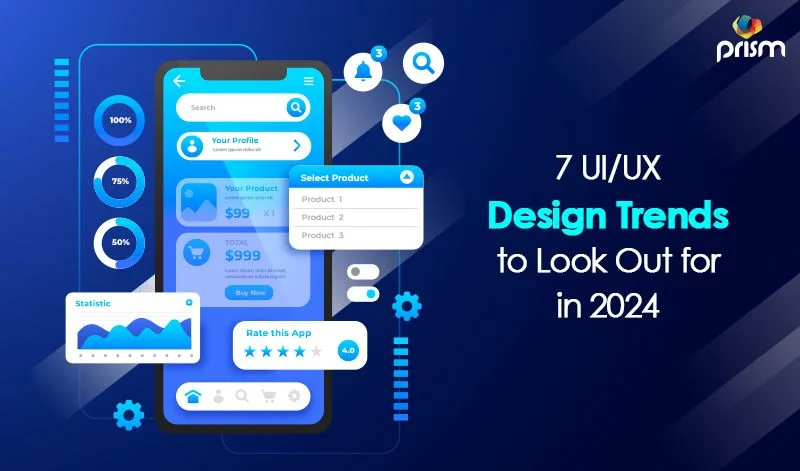

7 UI/UX Design Trends to Look Out for in 2024

Table Of Contents
1. The Evolution of UX/UI Design
The evolution of UX/UI design is closely intertwined with technological advancements, leading to significant changes in how designers approach their craft. Key elements driving this evolution include data-driven design, which leverages user data to tailor experiences more precisely.
There's also a heightened focus on accessibility, ensuring designs are inclusive for all users. Microinteractions have become integral, enhancing user engagement through subtle visual cues and interactions. Ethical design has emerged as a crucial consideration, addressing user privacy and data security concerns.
Additionally, collaborative tools have revolutionized how design teams work, enabling seamless cooperation across geographical boundaries. These elements collectively shape a more intuitive, inclusive, and responsible approach to UX/UI design.
2. Emerging Technologies in UX/UI Design
Emerging technologies like augmented reality (AR) and virtual reality (VR) are revolutionizing UX/UI design, offering immersive and interactive experiences. AR overlays digital information in the real world, while VR creates entirely digital environments.
Voice-driven user interfaces (VUI) are also on the rise, making interactions more intuitive and accessible. Emotionally intelligent design is gaining traction, focusing on understanding and responding to user emotions, and enhancing the overall user experience. These technologies are opening new horizons in UX/UI design, making it more dynamic, inclusive, and user-centered.
3. UI Design Trends for 2024
- Minimalism: This approach emphasizes clarity and functionality. By focusing on essential elements, minimalism helps users process information more effectively, reducing cognitive overload and improving the overall user experience.
- Neural Interfaces: These interfaces represent the next level of interaction, potentially enabling users to control technology through thoughts or neurological signals. This could revolutionize accessibility and create a more intuitive user experience.
- Dark Mode: Beyond aesthetics, dark mode is beneficial for reducing screen glare, making content more readable in low-light conditions and potentially reducing energy consumption on certain display types.
- Glassmorphism: With its transparent, frosted-glass effect, glassmorphism adds depth to the design. It helps distinguish different layers of the UI, making the interface more intuitive and visually appealing.
- Immersive 3D Environments:By creating a sense of depth and realism, 3D environments enhance user engagement, particularly in applications where a lifelike experience is key, such as in virtual reality or gaming.
- AI Integration: AI can tailor the user experience based on individual behaviors and preferences. This personalization can make interfaces more efficient and user-friendly.
- Retro UI Elements: Incorporating retro design elements can evoke nostalgia and differentiate a product. This trend often appeals to users' emotions, adding a unique character to the interface.
4. Future Challenges and Opportunities
UX/UI designers in 2024 will navigate challenges like ensuring data privacy in an increasingly digital world, where protecting user information is paramount. Designing for diverse populations also presents a challenge, requiring inclusivity and accessibility in design to cater to varied user needs.
On the flip side, digital expansion and AI offer opportunities to enhance personalization and efficiency in design. AI's ability to analyze user behavior and preferences will enable more tailored and intuitive user experiences, making design decisions more impactful and user-centric.
5. Preparing for the Future in UX/UI Design
Importance of Lifelong Learning:
UX/UI designers must commit to continuous learning to keep pace with rapid technological changes. This includes staying informed about latest trends, attending workshops, and participating in online courses.
- Adapting to Emerging Technologies: Designers should be proficient in emerging technologies such as AI, AR, VR, and voice UI. Understanding these tools can help create more dynamic and immersive user experiences.
Ethical Design: A Core Principle
- Data Privacy and Security: In an era where data breaches are common, prioritizing user privacy and security in design is crucial. Designers must understand the ethical implications of their work.
- Designing Responsibly: Ethical design also involves making conscious decisions that do not harm users or society. This includes considering the long-term impacts of design choices on users and communities.
Accessibility: Designing for All
- Inclusive Design Practices: Accessibility should be a key consideration in UX/UI design, ensuring that digital products are usable by people with a range of abilities.
- Tools and Guidelines: Utilizing tools and following guidelines like the Web Content Accessibility Guidelines (WCAG) can help make designs more accessible.
Cultural Relevance in a Globalized World
- Understanding Diverse User Groups: As the user base becomes increasingly global, understanding cultural nuances and designing for a diverse audience is essential.
- Cultural Sensitivity: This involves research and empathy to ensure that designs are culturally sensitive and do not inadvertently offend or alienate users.
Final Word
As we conclude this blog on UX/UI design trends for 2024, it's evident that this field is undergoing a significant transformation. With the integration of advanced technologies like AR, VR, and AI, alongside a heightened focus on ethical design, accessibility, and cultural relevance, UX/UI designers are poised to create more intuitive, inclusive, and impactful user experiences.
The future of UX/UI design promises to be both challenging and exciting, offering endless opportunities for innovation and creativity. Engaging in continuous learning and staying adaptable to emerging trends will be key for designers to thrive in this ever-evolving domain.
Prism Digital, the best design agency in Dubai is at the forefront of innovations in the UI/UX design space. Our design experts are well-equipped with the latest tools and are ready to transform your ideas into vibrant realities. If you need guidance with web designing, application UI/UX design, or other bespoke project needs, reach out to us now!

About The Author: Lovetto Nazareth
Lovetto Nazareth is a digital marketing consultant and agency owner of Prism Digital. He has been in the advertising and digital marketing business for the last 2 decades and has managed thousands of campaigns and generated millions of dollars of new leads. He is an avid adventure sports enthusiast and a singer-songwriter. Follow him on social media on @Lovetto Nazareth
Post Your Comment!
Recent Blogs
Abu Dhabi: A Thriving Hub for brand logo design
Human-Designed Logo Still takes the cake… at least in the Dubai Market
Guide to Grow Business in Abu Dhabi: Top Advertising Agency in UAE
Digital Dominance Why do you need a Top Web Development Agency in Dubai?

Support
Phone: +971 55 850 0095
Email: sales@prism-me.com
Location: Prism Digital Marketing Management LLC Latifa Tower, Office No. 604 - West Wing World Trade Center 1, Sheikh Zayed Road Dubai, UAE
Subscribe
Join our newsletter to stay up to date on features and releases.
By subscribing you agree to our Privacy Policy and provide consent to receive updates from our company.
